Installation And Upgrade SongBook runs on all Palm Powered® handhelds with at least Palm OS 3.0. The songbook zip archive contains the application, SongBook.prc, as well as a comprehensive chord libary with more than 2,700 guitar chords, Chords.pdb, and a sample song Greensleeves.pdb. You can install all three files with the standard Palm installation program. If you find the large number of chords in Chords.pdb intimidating, you can install a smaller chord database with only 200 commonly used chords instead. If you upgrade from a previous SongBook version, just install over the old version. This way, songs entered in the previous version will be preserved. Note that when you install the new enhanced chord database, all changes you've made to the original chord database will be lost. The SongBook application can be moved into Flash ROM or onto an expansion card. Where To Find Songs For SongBookSongBook understands the widespread chordpro song format that writes chords in square brackets within the lyrics. While we cannot provide songs at this site due to copyright restrictions, the Internet has huge archives of songs in chordpro format. Simply type "chordpro" into your favorite search engine. You can also easily create your own songs. Just write the lyrics as usual and insert the chord names in square brackets at the appropriate positions as in the following example: [Em]Alas, my [G]love, you [D]do me [Bm]wrong, A detailed explanation of the chordpro format is below. How To Get Songs Into SongBookUse Windows SongBookImporter or Conduit
Download and install our free SongBook tools for Windows. Drag-and-drop chordpro files onto the SongBookImporter and click Install. After the next HotSync, the songs will be available in SongBook. If you're using the SongBook conduit, you can copy the files into the song directory on your PC, and they will automatically appear in SongBook after the next HotSync. Transfer via Memo
Copy/paste the songs into the Memo application in Palm Desktop, perform a HotSync, then open SongBook, go to the song list, and select menu - Songs - Import Memo. Copy files on expansion card
If you have a card reader, you can copy your songs as *.pro files into directory /PALM/Programs/SongBook/ or a sub directory thereof. Open SongBook and select menu - Songs - Card - Scan Card to update the SongBook card cache. 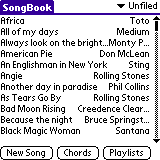 Song List Song List
The song list displays title and sub title (to the right) of all songs currently in your SongBook database. You can filter the song list by category, or sort it by title or sub title (menu). Entering a letter will jump to the first title (subtitle) starting with that letter. Use the menu to beam a category of songs to another handheld, or import songs from MemoPad. Tap on a song and hold the stylus for a second to get a pop up menu that lets you quickly add a song to a playlist, or delete it.
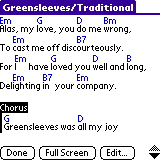 Song View Song View
The song view displays the current song with lyrics and chords. Tap on a chord to look up the chord definition. You can switch the display of chords and tabs on or off by tapping menu - Song - Show/Hide Chords. You can also transpose the song into a different key by tapping on menu - Song - Transpose.
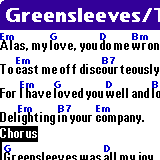 Change lyrics, chords, and tab fonts and colors in the Preferences. Additional small and tiny fonts are available on handhelds with high-res displays. SongBook supports switching between portrait and landscape mode, and resizing the virtual Graffiti area of the Clié and Tungsten T3 models. Change lyrics, chords, and tab fonts and colors in the Preferences. Additional small and tiny fonts are available on handhelds with high-res displays. SongBook supports switching between portrait and landscape mode, and resizing the virtual Graffiti area of the Clié and Tungsten T3 models.
Use the menu to beam the currently displayed song, or export the song to MemoPad. Only the lyrics will be exported if you have switched off the chord display.
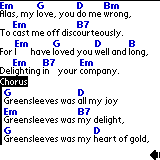 Full Screen Mode Full Screen Mode
To make maximum use of screen real-estate, SongBook can display a song in full screen mode where the whole display is used to display the song. Tap on the small left arrow in the upper right corner or anywhere in the Graffiti area to end full screen mode. Tap on the upper/lower half of the screen to scroll up/down by one page. Auto-ScrollingTo start automatic scrolling, tap on menu Song - Auto-Scroll. A small panel with accelerator (+) and decelerate (-) buttons and the current tempo will be displayed. You can also increase or decrease speed with the page up/page down buttons. Tapping on the display will halt scrolling for approximately one second - useful if you find the song scrolls just a little bit too fast. The panel can be switched off in Preferences. You can pre-define a tempo for a song with the {tempo: } directive.
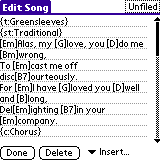 Song Edit Song Edit
You can change songs or add new songs. You can also change the category of a song here. Tap on the Insert... popup to insert predefined control statements (see chordpro format below).  
Expansion Card Support SongBook transparently supports songs stored on expansion cards. Songs on expansion cards will appear in the standard song list view and are indicated with a small card icon. You can hide the card icon by setting a preference option. SongBook transparently supports songs stored on expansion cards. Songs on expansion cards will appear in the standard song list view and are indicated with a small card icon. You can hide the card icon by setting a preference option.
To move all songs in a given category to or from an expansion card, go to the song list view, and tap on menu Songs - Card... You can also move individual songs to and from a card in the song view. For performance reasons, SongBook caches title and sub title of all card songs in its main database. SongBook will recognize most external changes to the expansion card, or switching to a different expansion card. However, in some cases, you may need to perform a manual card scan to update the song cache. Tap on Scan Card in the Expansion Card dialog to perform this scan. On the expansion card, songs are stored in sub directories of /PALM/Programs/SongBook with the same name as the category they appear in. Unfiled songs will be stored in the main SongBook directory. 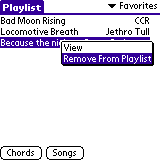 Playlists Playlists
Playlists are collections of songs for a special purpose, e.g. a concert, or training. Playlists contain references to songs independent of their categories. You can add songs to multiple playlists, and one song can occur multiple times in one playlist. Use the menu in Song view to add or remove songs to/from a playlist. Alternatively, you can tap-and-hold the stylus on a song in the song list or playlist to add/remove it to/from a playlist. To change the order of songs in a playlist, tap on the song, and drag the stylus up and down the list. You can beam playlists to other handhelds that also have SongBook installed. Note that this will not beam the songs referenced in the playlist. An exclamation mark (!) indicates playlist songs that are not available on the handheld.
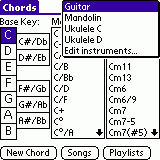 Chords Chords
SongBook comes with a comprehensive chord library that contains more than 2,700 chords. Chords are sorted by base pitch and major/minor. Each chord can have several variations. SongBook knows about identical pitches (e.g. C# = Db). For beginners, a smaller chord database with only 200 commonly used chords is also available. You can add your own chords or change existing chord definitions.
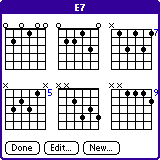 Chord View Chord View
SongBook can display multiple variations of a chord. If there are more variations to a chord that fit on one screen, small scroll arrows will appear in the lower right corner. Chords that are locally defined in a song will be displayed first and have a border around it. Select a chord and tap Edit to modify or delete this chord.
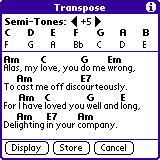 Transposing Transposing
SongBook lets you transpose a song to a different key by automatically adjusting all chords. You can decide if you only want to display the transposed song, or if you want to change it permanently, or create a copy. Note that if the song contains special chord definitions, these will usually no longer be valid after transposing.
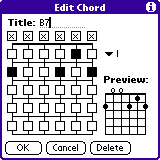 Chord Edit Chord Edit
You can change any chord in the chord database. Select the base fret in the pulldown to the right, then click on the finger spots. If a string does not sound (is muted), select the x above the string. Use menu Chords - Find Matching Chords to find all chords that match the current finger settings.
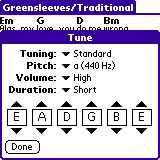 Tuning Tuning
SongBook contains a simple guitar tuner. You can choose from one of several predefined tunings or set your own custom tuning by tapping on the arrows above and below the string labels. SongBook will try to adjust the chord definitions according to your tuning. Note that this may sometimes lead to non-optimal fingerings. A small T in the chord view reminds you of a non-standard tuning. When you play with others, you may need to adjust the base pitch (default is 440 Hz). You can adjust the base pitch in quarter-tone steps. The volume and pitch settings are also used when playing chords.
Chordpro FormatSongBook stores songs in the chordpro format, a simple format for notation of lyrics together with chords. Use your popular Internet search engine to find huge collections of songs in chordpro format in the Word Wide Web. In the chordpro format chords are denoted in square brackets [] in the text, e.g. [Em]Alas, my [G]love, you [D]do me [Bm]wrong, SongBook will render this as Em G D Bm
Alas, my love, you do me wrong, In addition to the chords in square brackets, the chordpro format defines several control sequences in curly brackets {}. Songbook understands the following control statements: {title: ...} or {t: ...} | Song title. This is displayed in the song list screen and in the title bar. | {subtitle: ...} or {st: ...} | Song subtitle, typically the interpret or composer. This is displayed in the song list screen and in the title bar. | {comment: ...} or {c: ...} | Comment, e.g. Repeat 2x or Chorus. Comments are rendered inverse. | {soc} and {eoc} | Start and end of chorus. Chorus is indicated by a black line to the left. | {sot} and {eot} | Start and end of tab. A tab (tablature) section is rendered in a fixed width font. | {define ...} | Used to define a special chord for this song. The chord format is
<chord name> <base fret> <string 6> ...<string 1>, i.e.
G 1 3 2 0 0 0 3 | # | Lines starting with # are comment lines and are ignored in the song view. | {tempo: ...} | (SongBook specific) Defines scroll speed used for auto-scrolling. |
Windows ToolsIf you're on Windows, you can install the SongBook tools, consisting of a conduit that synchronizes songs and playlists with a directory of your choice, and an import program that lets you easily add songs in chordpro and tab format to SongBook. The conduit will automatically synchronize all SongBook songs with a directory of your choice. To set the directory, right-click on the HotSync manager icon in the tasktray, select Custom... - SongBook. It supports the usual three synchronization options (Synchronize, Handheld overwrites Desktop, Desktop overwrites Handheld), and can synchronize with multiple PCs. Note that for technical reasons, songs are ignored during HotSync if they are stored on an expansion card. Songs will be stored as <title>-<subtitle>.pro files in sub directories of the song directory, corresponding to their categories. Songs in the Unfiled category are stored in the main song directory. Note that Palm OS supports only 15 categories, so you can't have more than 15 sub directories. Playlists will be stored as *.lst files in the song directory. The first line is the actual playlist name, the following lines contain the title and sub title of a song, separated by a dash, e.g. Greensleeves - Traditional 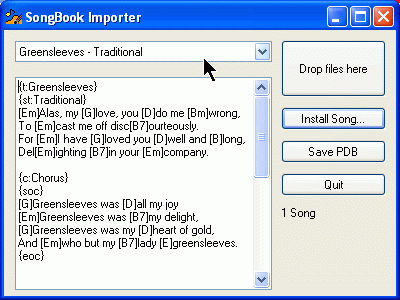 The SongBook importer lets you easily import songs into SongBook. Simply drop files from explorer onto the SongBook Importer Window and click Install Song... when you're done. After the next HotSync, the new songs will appear in the SongBook application. The SongBook importer lets you easily import songs into SongBook. Simply drop files from explorer onto the SongBook Importer Window and click Install Song... when you're done. After the next HotSync, the new songs will appear in the SongBook application.
Alternatively, you can save the converted songs as a Palm database (PDB), and import them later manually. Files ending with .tab or .crd are considered in tab format (chords in separate lines above the text). The SongBook Importer will try to convert these songs into chordpro format, by placing chords within the text. Note that importing a song in tab format usually requires additional work (e.g. add {title: } and {subtitle: } statements). You can also import additional chord definitions. Chord definition files should contain one or more lines in the following format: <chord name> <fret string 6> <fret string 5> ... <fret string 1> e.g. Am 5 7 7 5 5 5 Shareware License SongBook is distributed as shareware, i.e. try before you buy. When you continue to use SongBook after an initial trial, you must purchase a license. Licensed users will receive free support and information about program updates. Registered users of a 1.x version of SongBook can upgrade to SongBook 2.x for a reduced fee. Feedback Do you have a song that is not rendered correctly? Is an important chord missing in the chord database? Please let us know. Version History- 2.0
- Playlists (song collections, e.g. for a concert)
- Improved transpose dialog with preview of current song
- Additional font on high-res devices
- More alternative tunings, support for custom tuning
- Support for landscape and portrait extended screen of Sony Clié devices
- New menu options for duplicating songs or removing all songs in a category
- Windows conduit for synchronizing songs with desktop
- 1.4 (5-Feb-04) - bug fix with chord lookup on certain OS versions
- 1.4 -
Auto-scrolling
Selectable font for tablatures, color for text, chord and tabs
Option to set longer auto-off time within SongBook, no auto-off during auto-scroll
Resizable chord view
Recognize chord names w/o parentheses, e.g. B7b9 -> B7(b9)
- 1.3 -
Support for Tungsten T3 virtual silkscreen and Tungsten five-way navigator
Ability to export lyrics only to memopad (if song view set to lyrics only)
- 1.2 -
Better search, search titles/sub titles and memory first, then card
Improved rendering of chord labels: chords no longer overlap, less space after chord, dashes in stretched words
Option to permanently store transposed songs
Support for small and tiny fonts on high-res displays
Lyrics only mode will also hide tab
Preference option for not scrolling past end/beginning of song
Support for Tungsten five-way button in song view
Play chord in edit mode
Non-standard tunings: adjust chords according to current tuning
Added many chords with bass notes to chord database
- 1.1 -
Support for expansion cards,
Support for other chordpro directives, ignore (don't display) unknown directives,
Faster chord lookup,
Search for text in songs, enter first letter in song list to scroll to a song,
Improved transposition form,
Comprehensive chord database with almost 2,000 chords,
Support for open strings in chords in higher frets
Support for virtual Graffiti area of Sony and Handera models
- 1.0 - first public version
Special thanks to Kenny Song and Laurence Esterhuizen for their work on the chord database and numerous valuable suggestions.  
| 
 The SongBook importer lets you easily import songs into SongBook. Simply drop files from explorer onto the SongBook Importer Window and click Install Song... when you're done. After the next HotSync, the new songs will appear in the SongBook application.
The SongBook importer lets you easily import songs into SongBook. Simply drop files from explorer onto the SongBook Importer Window and click Install Song... when you're done. After the next HotSync, the new songs will appear in the SongBook application.  Song List
Song List Song View
Song View Change lyrics, chords, and tab fonts and colors in the Preferences. Additional small and tiny fonts are available on handhelds with high-res displays. SongBook supports switching between portrait and landscape mode, and resizing the virtual Graffiti area of the Clié and Tungsten T3 models.
Change lyrics, chords, and tab fonts and colors in the Preferences. Additional small and tiny fonts are available on handhelds with high-res displays. SongBook supports switching between portrait and landscape mode, and resizing the virtual Graffiti area of the Clié and Tungsten T3 models. Full Screen Mode
Full Screen Mode Song Edit
Song Edit SongBook transparently supports songs stored on expansion cards. Songs on expansion cards will appear in the standard song list view and are indicated with a small card icon. You can hide the card icon by setting a preference option.
SongBook transparently supports songs stored on expansion cards. Songs on expansion cards will appear in the standard song list view and are indicated with a small card icon. You can hide the card icon by setting a preference option.
 Chords
Chords Chord View
Chord View
 Chord Edit
Chord Edit Tuning
Tuning